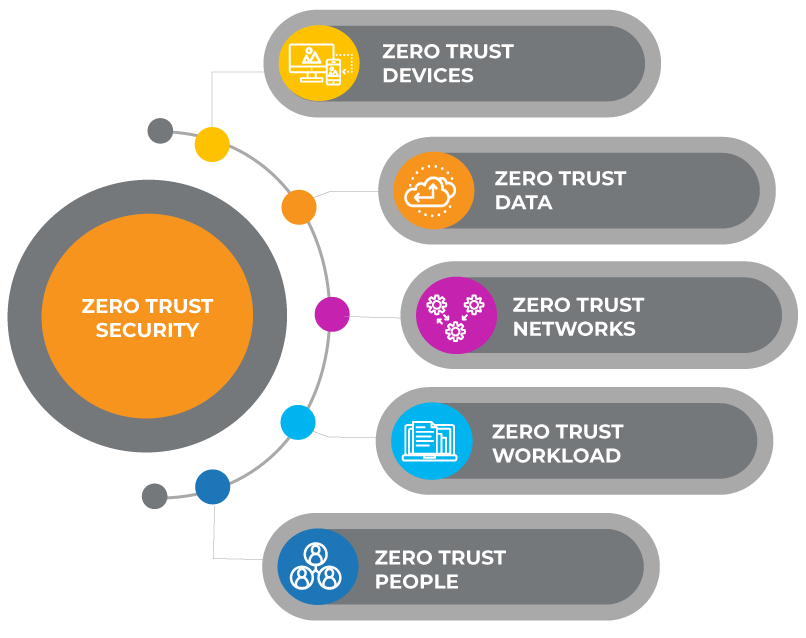The digital landscape is a battlefield, and cyber threats are evolving faster than ever. Traditional castle-and-moat security models, built on trusting anyone inside the perimeter, are increasingly vulnerable. This is where Zero Trust emerges as a game-changer, offering a paradigm shift in cybersecurity.

What is Zero Trust?
Imagine a world where trust is not granted by default, but continuously evaluated based on context and behaviour. That’s the essence of Zero Trust. It assumes everyone, inside or outside the network, is a potential threat and requires continuous verification before granting access to any resources. Zero Trust advocates for continuous verification of every user, device, and network resource attempting to connect to the network. This approach minimizes the risk of unauthorized access and lateral movement within the network, making it significantly harder for cybercriminals to exploit vulnerabilities.
Key Principles of Zero Trust Implementation
- Identity-Centric Security: Identity is at the core of Zero Trust. Organizations must authenticate and authorize every user and device before granting access to resources. This involves implementing multi-factor authentication, least privilege access controls, and continuous monitoring of user behaviour.
- Micro-Segmentation: Network segmentation is crucial in a Zero Trust environment. By dividing the network into smaller segments and restricting communication between them, organizations can contain potential threats and limit the impact of a breach.
- Continuous Monitoring: Real-time monitoring of network traffic, user activity, and system behaviour is essential for detecting anomalies and potential security incidents. Automated tools can help organizations identify suspicious activities and respond promptly to mitigate risks.
- Encryption: Data encryption plays a vital role in protecting sensitive information from unauthorized access. Implementing end-to-end encryption ensures that data remains secure both in transit and at rest.
Why is Zero Trust crucial for cyber resilience?
- Reduced attack surface: By segmenting your network and granting least-privilege access, you minimize the potential impact of a breach. Even if attackers infiltrate a segment, they’re locked out of others.
- Improved threat detection: Continuously monitoring user behaviour and activity helps identify anomalies and suspicious actions, leading to faster incident response.
- Resilience Against Advanced Threats: Zero Trust mitigates the risk of insider threats, external attacks, and lateral movement within the network, making it harder for cybercriminals to infiltrate systems.
- Enhanced compliance: Zero Trust aligns with data privacy regulations like GDPR and CCPA by minimizing unnecessary data access and exposure.
Strategic Implementation: Building Your Zero Trust Fortress
Implementing Zero Trust isn’t a one-time event; it’s a journey. Here are key steps to get you started:
1. Define your strategy: Understand your specific security needs and risk profile. Identify critical assets and data to prioritize protection. 2. Assess your infrastructure: Evaluate your current network architecture, user access controls, and security tools. 3. Prioritize key areas: Start with securing identities, access control, and network segmentation. Implement multi-factor authentication (MFA) and role-based access control (RBAC). 4. Leverage technology: Utilize tools like identity and access management (IAM), endpoint security, and network segmentation solutions. 5. Continuously monitor and adapt: Regularly evaluate your Zero Trust implementation, identify gaps, and adjust your approach based on evolving threats and needs.
Remember:
- Change management is key: Get buy-in from stakeholders and educate users about the benefits and responsibilities of Zero Trust.
- Start small, scale gradually: Don’t try to do everything at once. Begin with a pilot project and gradually expand your Zero Trust implementation.
- Seek expert guidance: Partner with cybersecurity professionals to assess your needs and design a tailored Zero Trust strategy.
Conclusion
Embracing Zero Trust in cybersecurity is not just a best practice; it is a strategic imperative for organizations seeking to fortify their defences against evolving cyber threats. By adopting a Zero Trust approach, organizations can enhance their cyber resilience, protect sensitive data, and stay ahead of malicious actors in an increasingly complex threat landscape. It’s time for organizations to shift from a perimeter-based security mindset to a Zero Trust mindset – one that prioritizes continuous verification, strict access controls, and proactive threat detection.
Ready to embark on your Zero Trust journey? Start by challenging the assumption of trust and embrace the power of continuous verification!
By: DESTINY YOUNG | IT Operations and Technology Infrastructure Engineer

























